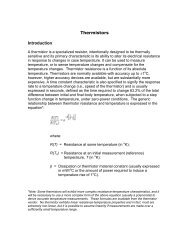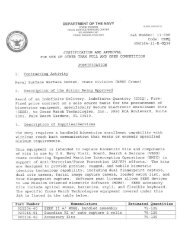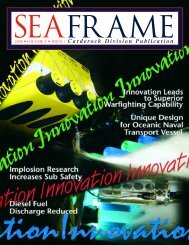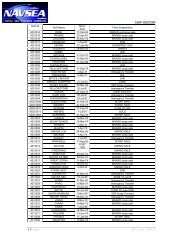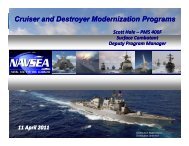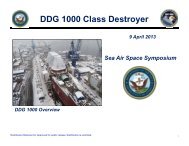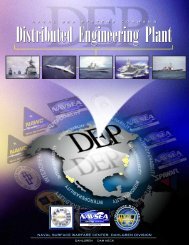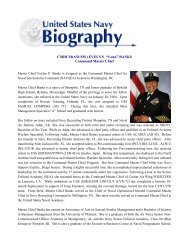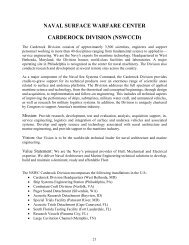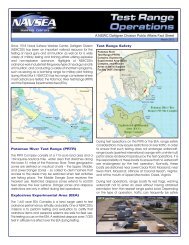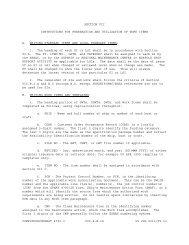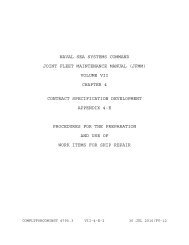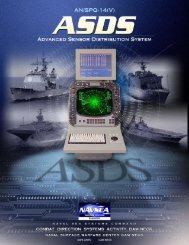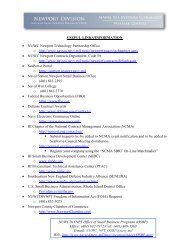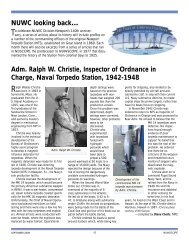Volume 6, Issue 1 - Naval Sea Systems Command - The US Navy
Volume 6, Issue 1 - Naval Sea Systems Command - The US Navy
Volume 6, Issue 1 - Naval Sea Systems Command - The US Navy
You also want an ePaper? Increase the reach of your titles
YUMPU automatically turns print PDFs into web optimized ePapers that Google loves.
SEAFRAME<br />
14<br />
Core equities<br />
ENVIRONMENTAL<br />
MONITORING AND<br />
OPERATOR GUIDANCE SYSTEM<br />
AND CHANNEL ANALYSIS AND<br />
DEPTH EVALUATION TOOL<br />
A Set of Tools Which Save Dredging Costs<br />
and Help Deep-Draft Ship Navigation<br />
By<br />
Charles<br />
Traugh<br />
In the 1980s, the <strong>Navy</strong> became aware<br />
of grounding problems with deep-draft ships<br />
entering ports through channels exposed to<br />
waves, specifically at Kings Bay, Ga. <strong>The</strong><br />
recommended channel depth for unrestricted<br />
access to the <strong>Naval</strong> Submarine Base at Kings<br />
Bay was a 55-foot depth. Dredging costs had escalated to<br />
the point where the <strong>Navy</strong> could afford to maintain only a<br />
46-foot depth in channels. Dredging to this depth, ships had<br />
a probability of grounding 10 percent of the time, and the<br />
<strong>Navy</strong> wanted to establish a method to determine when the<br />
transiting through that channel was safe.<br />
To solve this problem, Carderock Division engineer<br />
Andrew Silver came up with the Environmental Monitoring<br />
and Operator Guidance System (EMOGS), a computational<br />
method used by the submarine squadron to determine<br />
whether the environmental conditions in the channel will<br />
provide enough under-keel clearance to permit transit of a<br />
channel minimizing the possibility of grounding. It saves<br />
the <strong>Navy</strong> money by permitting use of a channel whose<br />
depth is less than required for unrestricted access by actually<br />
calculating distances between a ship’s keel and the channel<br />
bottom. <strong>The</strong> shallower entrance channel depth precludes<br />
expensive and unnecessary dredging operations. A test of<br />
the system came shortly after EMOGS was installed in the<br />
wake of Hurricane Hugo in 1989. EMOGS predicted a large<br />
risk of grounding due to the large vertical submarine motions<br />
produced from the hurricane waves. From this EMOGS<br />
prediction, the submarine was waived off from transiting the<br />
channel during that time.<br />
EMOGS calculates the risk of grounding by<br />
calculating the difference between the depth of water in the<br />
channel and the predicted extreme vertical displacement<br />
of the deep draft ship. Astronomical data are used to<br />
calculate tidal heights, and measurements of weatherrelated<br />
phenomena, such as the presence of high pressure<br />
or low pressure atmospheric pressure patterns, are gathered.<br />
Wind speeds and directions that could increase or decrease<br />
the water level in the channel are also taken into account.<br />
Finally, U.S. Army Corps of Engineers surveys are examined<br />
for potential areas of rapid sediment build-up, or “hotspots.”<br />
<strong>The</strong> factors included in calculating extreme vertical<br />
displacement of the deep-draft ship are the ship’s static<br />
draft, its sinkage and trim at speed, and the wave-induced<br />
vertical motions at each end of the ship. <strong>The</strong> wave-induced<br />
vertical motions are calculated by combining the heave<br />
and pitch response amplitude operators with the measured<br />
wave spectra from buoys located along the channel.



